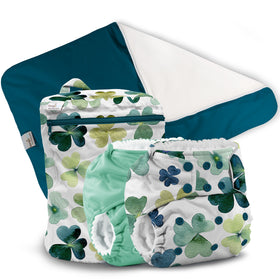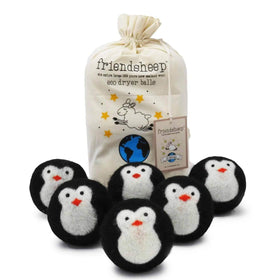#1) Poor Diaper Fit
This is the most common reason why we see diaper leaks with our clients. Are the diapers too loose or too tight? Try adjusting them a little differently to see if it makes a difference. The diaper should fit flush all the way around the thighs with no gaps and snugly around the tummy so that there is no drooping even when baby is in motion. Don't be afraid to tighten the diaper well. The elastics are made to stretch; so use the stretch to your advantage.
Thigh elastics should sit roughly where underwear would. Pinch the diaper in the middle as you pull it up and over baby to get those elastics sitting in the right spot for the best leak control. Once the diaper is fastened, move baby's legs gently up and down and side to side keeping an eye out for any gapping around the legs.
Also, look for 'Plumber's Crack'. If you can see baby bum crack when baby is standing, squatting or sitting then the rise of the diaper is not high enough which will invite leaks up the back. Let out a rise snap if you are using one size type diapers or size up to the bigger size on sized diapers to fix this.
If you're using a prefold, flat, pre-flat, contour or fitted diaper with a cover on top, make sure that all of the absorbent material is tucked into the cover. Any parts of the diaper peeking out from under the cover will wick moisture onto clothing causing a leak.
TIP #1: For boys, always point the penis down, centered between the legs. When they point up and/or to the side it's an invitation for leakage.
TIP #2: Newborns pee a lot, but not with very much force. If you're using diapers for a newborn with a stay dry top (like microfleece), sometimes they don't pee with enough force to get wetness through the stay dry layer to the absorbency underneath. This results in leaking over the hip and up the back as newborns spend a lot of the day reclined. Because of this, natural fabrics are preferable for newborns as they absorb more quickly preventing this. If you have stay dry diapers and you think this is the issue your newborn is having, never fear, simply put in a natural fabric booster, flannel washcloth or other natural fabric liner between diaper and baby and that should help.
TIP #3: If you are using onesies that snap at the crotch, they will often compress the cloth diaper between the legs and cause leaking around the thighs creating wet spots on the pants or onesie. Your solution is to size up on onesies so they snap without putting pressure on the diaper, use a onesie extender or simply don't snap the onesie and tuck it into the pants instead or leave it loose on top.
TIP #4: If you are using pocket style diapers, make sure that the insert you are using spans the entire width of the pocket. If your insert is too skinny for the size of the pocket, the insert could shift around or leave a space on each side where there will be no absorbency.
Sometimes though, certain diapers just don't work for some babies. Generally speaking, the better quality brands will fit the most baby body types successfully. Super cheap diapers will often fit poorly, and can be sewn inconsistently using lesser quality materials and hence may not work for you despite an attractive price point. As a general rule, you get what you pay for in terms of diaper quality.
#2) Lack of Absorbency
If the fit of your diapers seems okay, then consider the absorbency that your diapers offer. When you change the diaper is it soaking wet? Is baby being changed frequently enough? Newborns pee a ton and should be changed every 1-2 hours around the clock and older babies every 3-4 hours (unless they poop) whether they are in cloth diapers or disposables. Roughly correlated with feeding times as an easy way to remember. If your diapers are reaching capacity and leaking between changes your solutions are to either change more frequently, switch to a more absorbent style of diaper or add absorbency to the current diaper (in the form of additional inserts or boosters). You may add as much extra absorbency as necessary as long as it don't compromise proper fit by causing leg gaps. Add absorbency where baby needs it. Boys might soak the front and leak even though the back of the diaper seems dry (add boosters to the front where wetting occurs most). Girls might soak more through the middle, so add more there if that situation is true for you.
*Nighttime leaks - A note about nights... the diapers you use successfully during the day will rarely continue to work overnight once baby begins to sleep longer stretches (roughly 6+ months). For nights or naps, a fitted style diaper with a PUL or wool cover can help give you max absorbency for a dry and happy sleep.
#3) Repelling Issues
If you are sure that that fit and absorbency of your diapers is adequate, then your issue might be repelling. Repelling is due to buildup on your diapers and usually happens after you have used them successfully for a while. Buildup can be from hard water mineral deposits, too much detergent that isn't being adequately rinsed out, non cloth diaper friendly (petroleum based) bum ointments or dryer sheets among other things (say a crayon that went through the dryer thanks to your toddler). Usually classic repelling is also accompanied by smelly diapers or a rash and an adjustment in detergent and/or wash routine is in order. However, repelling can also happen with natural fabrics like cotton, bamboo or hemp that haven't been properly pre-washed before use.
Manufacturer Defects
Very rarely, your diaper may have a defect from factory that causes leaking due to poor fit, sewing mistake, delaminated PUL etc. Often issues such as these are under warranty for a period of time after you purchase your diaper. Contact the manufacturer to rectify situations such as these.



